Source: Meteorite Labs
In the first two industrial revolutions, humans gradually replaced muscle power with mechanical power. In the fourth industrial revolution led by AI, we are replacing cognitive ability with computing power.
In the past year, with the rapid development of generative AI models such as ChatGPT, AI has expanded from simple automation tools to complex decision-making and prediction systems, and is gradually growing into a driving force for the progress of contemporary society. AI has become a hot topic in the European and American capital circles, and a topic of conversation at offline exchange gatherings for scientific and technological personnel.
This trend has also spread to the Web3 market, becoming a major collision between the two hottest technologies.In 2024, a large number of AI concept projects were born in the Web3 industry, trying to integrate AI technology with blockchain. Some projects use AI's content generation, analysis and other functions to apply to Web3 fields such as GameFi, SocialFi, and data analysis. Some projects are building decentralized computing power networks and using blockchain to fight against the monopoly of computing power by large technology companies.
Just last week, Coinbase announced support for AI Agent developers to integrate into its MPC wallet through the Coinbase Developer Platform, becoming one of the first companies to provide developers with AI Agent on-chain payment infrastructure.
“AI Agents cannot get bank accounts, but they can get crypto wallets” — Coinbase CEO Ben Armstrong
From this point of view, the second half of Web3+AI is being driven by the explosion of the AI Agent track.
I. AI Agent: Why is Multi-Agent the future?
In the past year, research and topics on AI Agent have begun to explode. For example, projects such as AutoGPT, Hebbia, Glean, BabyAGI, Generative Agents, and MetaGPT have attracted tens of thousands of stars on Github and have become popular star projects. The valuation of AI Agent star startups such as Zapier, Glean, and Hebbia has reached $5.7 billion.
AI Agent, Artificial Intelligence Agent, or "AI Agent", is an agent that can perceive the environment for autonomous understanding, make decisions and perform actions. AI Agent can not only automate tedious processes, but also make accurate decisions and interact with the environment intelligently.
The prospects for AI Agent are very broad. IDC conducted a survey in its "Top Ten Trends in AIGC Application Layer in 2024", and 50% of companies have already piloted the use of AI Agent in certain work, and another 34% of companies are developing relevant application plans. It is estimated that by 2027, more than 60% of smartphones will have generative AI functions, laying a hardware foundation for the popularization of AI Agent.
However, the reality is that although AI Agent has the advantages of integrating multiple tools and powerful reasoning capabilities, it performs well in certain specific scenarios, but it often cannot provide the best solution when facing complex real-world tasks. This limits the current use of AI Agent by more people. In addition, it is difficult for AI Agents from different models and different AI ecosystems to form synergy.
Therefore, the next technological change in AI Agent is Multi-Agent System (MAS). The Multi-Agent system architecture consists of many independent and autonomous single AI Agents, which have their own unique domain knowledge, functional algorithms and tool resources, and can complete complex decision-making tasks through flexible interactive collaboration. Multi-Agent can not only greatly improve overall work efficiency, but also give more powerful ability to handle complex and diverse tasks.
To understand Multi-Agent more intuitively, let's take ant colony foraging as an example:
- Each ant is an independent agent with its own simple behavior rules
- When looking for food, ants release pheromones, which other ants can sense
- Through the collaboration of a large number of ants, the entire ant colony can find the shortest path to the food source
Through this example, we can see the core features of the Multi-Agent system:Multiple autonomous agents interact and collaborate with each other to complete complex tasks or solve problems together.In the future, we may even see a company with only a CEO founder and entirely composed of AI agents employees.
In general, AI Agent represents a new paradigm for the interaction between artificial intelligence and humans, which is expected to completely change the way people live and work and promote changes in the software industry. With the continuous advancement of technology and the expansion of application scenarios, AI Agent will play an increasingly important role in the future.
Second, what changes can Web3 + AI Agent bring?
In 2023, the new AI revolution brought by OpenAI has overturned the original models of various industries. We have also seen many related concept products in Web3 continue to emerge and land, and there have been solutions that use Crypto characteristics to develop AI, such as decentralized computing power and data.
Even in the current sluggish market, the AI narrative remains strong in Web3. Judging from the performance of currency prices alone, AI is the second largest narrative after Memecoin.
During the ETHCC conference held in Brussels this year, Ethereum co-founder Vitalik once again expressed his views on Web3 + AI:
In the short term, the development of AI is a "collaborative intersection" between humans and AI. In the long run, AI will solve many insurmountable challenges facing humans today, such as longevity and space travel. Web3 and decentralization will chart the path to this ideal for us, while preventing extreme situations where fully autonomous AI agents will destroy humanity.
In the future, Web3+AI Agent will become one of the important narratives. It can be foreseen that Web3 AI Agent will flourish in various Layer1 ecosystems. So what changes will the introduction of AI Agent, the latest trend in the field of AI, into Web3 bring?
1. What opportunities can Web3 bring to AI Agent?
Decentralization
Web3 provides a decentralized infrastructure that allows AI Agent to achieve self-hosting, avoiding the data privacy and security risks brought by centralization.
In Web2, AI giants such as OpenAI and Anthropic have obtained a lot of financing and have access to training data for closed-source AI models. In addition to causing single-point failures for AI Agents, they also limit community participation and collaboration, hindering the innovation and progress of AI Agents.
Deterministic execution environment
Web3 provides a deterministic execution environment for AI Agents, which is not affected by artificially established trust elements, unnecessary intermediaries, and other inefficiencies.
AI Agents cannot get bank accounts and cannot book flights for users; but they can get wallets and use crypto stablecoins to trade with users, merchants and other AIs around the world.
Security and Privacy
Data privacy and security are one of the most challenging issues for AI Agents in practical applications of Web2. AI Agents need to collect and process a large amount of data, including personal information. Once the data is illegally accessed or leaked, it will cause serious damage to user privacy. Therefore, blockchain, which is naturally secure, can assist in ensuring data security.
Monetization and Investment Value
The monetization of AI Agents creates investment value for AI and inspires a new token economic model. Through the Initial Agent Offering (IAO) model, AI Agents can become a new investment target, delegating ownership to the community through DAO governance.
Market Transformation and Mass Adoption
Web3 provides a new market environment that encourages Web2 enterprises and developers to focus on creating unique and outstanding AI Agent projects to cope with competitive pressure and market demand. This will not only help enterprises take the lead in the Web3 environment, but also has the potential to drive the adoption of Web3 and blockchain by a wider range of Web2 users.
Optimizing AI Datasets and Models
Web3's unique features, such as decentralized and open and transparent data records, can optimize the diversity of AI datasets and the transparency of models. Using Web3 on-chain data to train AI models helps to build a large on-chain data model, providing unique perspectives and advantages.
2. What innovations can AI Agent bring to Web3?
Enhanced user experience
By combining the analytical capabilities of AI, Web3 applications integrated with AI Agents can provide users with personalized, automated, and customizable experiences, further unleashing the potential of the on-chain economy.
Lower the threshold for industry participation
AI Agent can be used as a tool to lower the threshold for people to participate in the Web3 industry. By acting as an "intelligent assistant" between users and on-chain protocols in Web3, it helps users complete various complex on-chain transactions, making Web3 products easier to use and conducive to large-scale adoption. For example, AI Agent can implement crypto investment analysis, automated on-chain transactions, and portfolio monitoring based on user needs.
Innovative applications
In the field of games and entertainment, AI Agent can provide dynamic and immersive experiences, enhance the value of user-generated content, and ensure transparency and reliability through blockchain technology.
In summary, Web3 + AI Agent not only promotes the progress of Web3, blockchain and AI technology, but also provides new opportunities for developers. The changes that Web3 brings to AI Agent are mainly reflected in decentralization, security, execution environment and monetization. In turn, AI Agent will also bring innovative applications and simplified user experience to Web3 through its own capabilities, improve efficiency and decision-making quality through automated execution of tasks, and lay the foundation for large-scale adoption of Web3.
III. Comparison of popular Web3 AI Agents
Spectral
Spectral is a project dedicated to building an AI Agent economy on the Web3 chain. It unleashes the innovative potential of combining AI and Web3 by providing zero-threshold smart contract compilation and deployment services.
Specifically, Spectral is offering two unique products:
Spectral Syntax is an on-chain AI Agent platform that can understand natural language intent and convert it into code-based instructions. It aims to allow Web3 users and developers to realize their intentions through specific AI Agents. Application scenarios include on-chain contract generation and deployment (one-click meme token issuance), smart contract vulnerability scanning and repair (smart auditing), on-chain information retrieval, etc. In the third quarter of 2024, Spectral will launch Syntax V2, allowing users to create their own AI Agents based on all of Spectral's tools, knowledge bases, and APIs to realize all kinds of imaginable intentions.
Spectral Nova is a machine intelligence network that focuses on the creation and application of AI and ML models. It attracts top data scientists and ML engineers through incentives to build models that output reasoning sources to solve prediction and machine intelligence problems of web3 applications, thereby meeting the needs of smart contracts, companies, and individuals for reasoning sources. Model creators, solvers, verifiers, and consumers interact with each other on Spectral's machine intelligence network to form a flywheel.
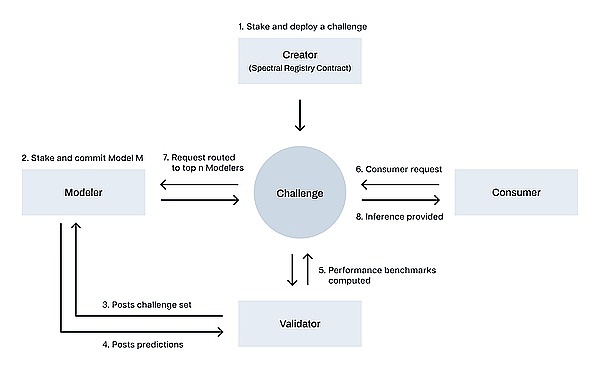
Inferchain is the Layer2 that Spectral is building and will be launched in the fourth quarter of 2024. Its vision is to become a universal, permissionless, open truth verification layer for verifying all on-chain AI Agent interactions. All AI Agents created on Syntax and the various inference sources they use from Nova will be integrated through Inferchain.
Spectral's core competitiveness in the Web3 + AI Agent track is reflected in:
Spectral provides one-click generation and deployment of smart contracts, which greatly reduces the threshold for Web3 development. This makes it easy for even novice users to compile and deploy smart contracts. It is an application scenario for AI for Web3.
Spectral's existing product architecture is highly adapted to the current diverse application scenarios of Web3, including DeFi, DAO governance, NFT, security audit and other fields.
Spectral continues to focus on the functional iteration and optimization of its core products Syntax and Nova to maintain its technological leadership.
Opportunities and Challenges: After the launch of Spectral's token $SPEC, FDV once reached $1.5 billion, with a total financing of $30 million. Backed by Web2 and Web3 head VCs such as General Catalyst, Social Capital, Jump Capital, Circle Ventures, Franklin Templeton, and Galaxy, it is one of the most noteworthy projects in the Web3 AI Agent track.
Spectral mainly targets the relatively small "AI for Web3" market, using generative AI technology and blockchain to popularize Web3 development and many functional scenarios, providing Web3 dApp with verifiable model reasoning capabilities, and expanding the scenarios of the Web3 application layer.
However, the three AI Agents currently launched by Spectral are all facing great homogeneous competition pressure. The operating paradigms of the four major roles in the Nova network require strong operational maintenance and external resource imports, and starting the growth flywheel is facing severe challenges.
Autonolas/Olas
Launched in the summer of 2022, Autonolas, also known as Olas Network, is a Web3 AI Agent ecosystem that operates by a single agent or multiple agents working together off-chain to complete tasks proposed by users and pass the output to the chain. At the same time, the completion process of the off-chain agent will also be recorded on the chain.
The uniqueness of Olas Network is that each built AI Agent is run by a separate operator, can extract data from any source, operate on different chains such as Ethereum, Solana, Polygon, and can perform complex processing such as machine learning. Through its Multi-Agent system, Olas Network allows users to collaborate with multiple AI Agents at the same time. Through the incentive mechanism, Olas Network connects AI Agent developers, operators, and guarantors to jointly support the development of the decentralized AI Agent ecosystem.
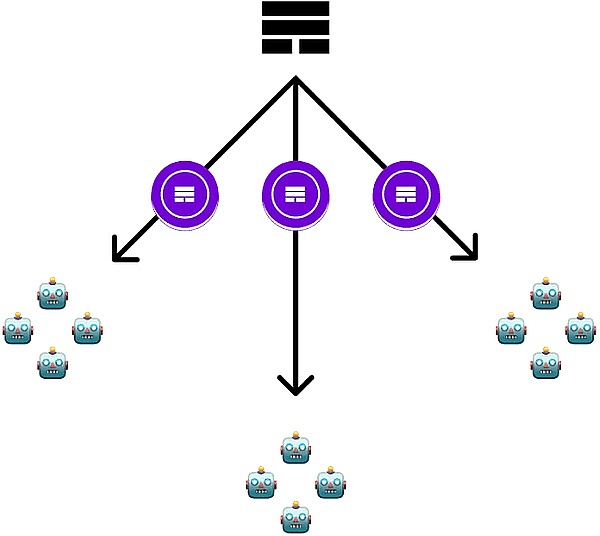
Olas Network's core competitiveness in the Web3 + Agent track is reflected in:
Web3 Native
Sponsored Business Content
As the core Multi-Agent development team of Fetch.AI, Olas' technical capabilities have been verified. AI Agents on Olas Network can run and interact autonomously in the Web3 environment. It can bring more efficient automation and intelligence to users.
Olas Network provides AI Agents with tools and infrastructure to build and manage DAOs. More efficient community governance and operations can be achieved.
Olas Network is highly composable, allowing developers to combine AI Agent components with different functions like building Lego blocks to build complex decentralized applications. This composability is a reflection of the Web3 "fat protocol" concept and helps accelerate innovation and application development.
Olas Network supports cross-chain operations, which is of great significance in the Web3 ecosystem where multiple chains coexist. Cross-chain capabilities can promote the flow of value and information interaction between different blockchain networks.
Opportunities and Challenges: Autonolas is one of the earliest projects in Web3 to propose the realization of Multi-Agent. After its token $OLAS was launched, its FDV once reached 4 billion US dollars, which is comparable to the top AI x Web3 projects such as IO.net and Aethir, indicating that the market's recognition of the narrative ceiling of Multi-agent is very considerable.
As a pioneer in connecting the Ethereum on-chain economy and off-chain AI Agents, Autonolas's "co-owned AI" idea is very consistent with Ethereum co-founder Vitalik's idea of Web3 to balance the risk of AI centralization.In terms of demand mining, OLAS Network, as the native team of Fetch AI, inevitably starts from the existing unmet demand scenarios of Web3, hoping to make the Web3 user experience better through AI, but it is also facing the growth resistance of low willingness on both sides of supply and demand.
MyShell
Myshell is a decentralized AI Agent consumer layer. Since it covers a large number of open-source and closed-source AI models, creators can quickly build AI Agent applications and easily capture users.
Specifically, MyShell consists of four core modules: model layer, developer platform, AIpp store, and incentive network. The first three modules include the underlying architecture of AI Agent, the entire process from creator production to end-user consumption, and the incentive network organically connects the first three to achieve a closed loop of the business model.
Interestingly, MyShell also allows developers to monetize AI Agents, but in a different way from ICO. In the newly launched AIpp store section, developers "package" their AI Agents as AIpps, and then pre-sell and public sell them. During the pre-sale stage, the share price will be calculated according to the Bonding Curve and will rise as the number of purchases increases. When 30 shares are sold or three days have passed, the pre-sale will end and the public sale will begin, and transactions will still be conducted according to the Bonding Curve.
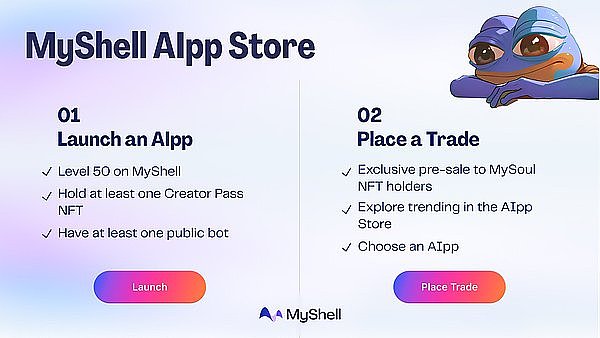
Developers have the right to purchase their own AI Agent shares during the pre-sale phase and receive 5% of each transaction as a handling fee.
MyShell's core competitiveness in the Web3 + Agent track is reflected in:
Compared to other projects, MyShell pays more attention to community building, and enhances user participation and loyalty through its badge system and other mechanisms.
MyShell's product development direction is more inclined to the current Web3 gameplay, especially the newly launched AIpp store, which is conducive to the rapid understanding and adoption of Web3 users.
Opportunities and Challenges: MyShell has raised more than 16 million US dollars in total and is one of the projects with the highest community activity and the most prosperous creator economy in the Web3 AI Agent track. Its AI chatbot launch method similar to Pump.fun is closer to the habits of Web3 users. In the first season that ended in July, more than 130 AI bots have been successfully launched, with a total transaction volume of more than 1.2 million USDT. From the perspective of long-term development, Myshell also needs to make major upgrades in product matrix and platform openness to face the fierce competition in the chatbot track and embrace the new paradigm of Multi-Agent.
HajimeAI
HajimeAI is an emerging "Web3 for AI" project that emerged in the second quarter of this year. It is the first project on Solana to propose the Solana sidechain structure, aiming to provide Solana L1 with stronger performance and more potential use cases ("L1's functional expansion layer"), while avoiding the liquidity dispersion caused by the Ethereum expansion model.
HajimeAI is the first Web3+AI Agent platform on Solana, serving as Solana's artificial intelligence application layer. It not only solves the current bottlenecks of decentralization, monetization, and reasoning capabilities faced by AI Agents, as well as multi-agent collaboration, but also lays a solid foundation for Solana's future personalized personal AI Agents and a thriving AI Agent ecosystem.
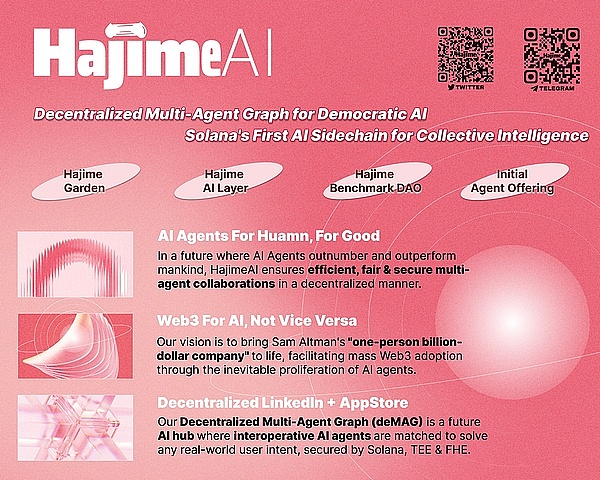
HajimeAI consists of three core components:
Web3's first AI Agent usability ranking, where any user can find the most suitable decentralized AI Agent. Hajime Benchmark DAO members rate each newly released AI Agent in Hajime based on key dimensions, in order to obtain the AI Agent's share of protocol revenue and Hajime token rewards.
In the early stages, HajimeAI will help empower Solana Saga and incentivize Solana Saga users to become initial members of Hajime Benchmark DAO through airdrops. By participating in the AI Agent selection, Solana OG users will have the opportunity to join the development of the Solana AI ecosystem while receiving platform incentives.
AI Agents evaluated by the DAO will be included in Hajime Garden, the intent center of the Hajime ecosystem. Based on the decentralized Multi-Agent Graph (deMAG) mechanism, Hajime Garden can decompose any intent proposed by users into multiple tasks and hand them over to professional AI Agents for processing. Whether it is five steps or ten steps, whether it is Web2 knowledge or Web3 interaction, any intent submitted will be perfectly executed.
Another core function of Hajime Garden is IAO, which is similar to IDO and aims to solve the monetization and centralization challenges faced by AI Agents in Web2. Compared with traditional financing, IAO's process is simpler and faster, allowing AI Agents to obtain the funds they need faster. The global participation feature of Web3 also makes DAO governance of AI Agent a reality.
The Solana L2 sidechain, which focuses on AI, runs in parallel with the Solana network, realizing "off-chain computing-on-chain verification", and still benefits from Solana's security and verifiability. All AI Agents in the Hajime ecosystem are built on the Hajime AI Layer, and multi-agent collaboration is achieved. The reasoning calculations required by AI Agents and the demand splitting capabilities of MAWG are supported by the Hajime AI Layer.
Opportunities and Challenges: As the winning team of the Solana Global Hackathon, it has proven its potential in the field of Web3 x AI. HajimeAI built Solana's first AI sidechain, becoming a key component for AI execution and meeting AI computing needs. Through the independently developed Muiti-Agent workflow graph deMAG and the innovative IAO mechanism, the development of on-chain interoperable AI Agents is accelerated, paving the way for the democratization and large-scale adoption of the Solana AI ecosystem.
However, HajimeAI has not yet released a test network and beta products. It remains to be seen whether on-chain AI Agents can realize the implementation of their interoperability vision and whether the performance of HajimeAI sidechains can support large-scale AI applications. But solving these problems will be the key to promoting the successful application of AI Agents in the Solana and Web3 ecosystems, which is worth looking forward to.
Theoriq
Theoriq aims to be a modular, composable AI Agent base layer, enhancing the way AI Agents communicate and interoperate with each other, ensuring that they are not only connected to each other, but also more autonomous and powerful than ever before. In addition, through token-based DAO governance, stakeholders can vote on proposals that affect the development of the Theoriq network to ensure that the network develops in accordance with the interests and values of the community.
Specifically, the Theoriq ecosystem consists of four roles: AI Agent developers, AI resource providers, Agent consumers, and projects
Infinity Hub is Theoriq's AI Agent development and aggregation platform, where developers can quickly build various AI Agents through tools and establish connections with AI resource providers such as computing power, models, and data. Any user or project in need can use stablecoins to obtain the right to use AI Agents in Infinity Hub.
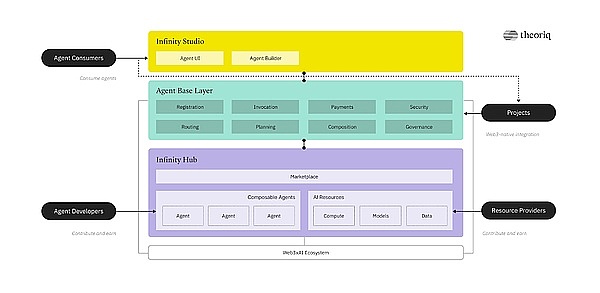
Whether it is a developer, data provider or user, a transparent algorithmic mechanism ensures that rewards are distributed in proportion to the value of the contribution, thereby maintaining fairness and incentivizing meaningful participation.
Theoriq's core competitiveness in the Web3 + Agent track is reflected in:
Theoriq is developing a composable AI Agent platform that allows users to piece together different AI Agents to create more advanced and flexible AI solutions.
Theoriq promotes the rapid innovation of AI Agent through incentive mechanisms, paving the way for it to become a modular and composable AI Agent.
Thoeriq's Infinity Hub provides services such as model training, reasoning, and data storage, and guarantees the accuracy of the model, anti-censorship, non-tamperability, and data privacy through proof mechanisms.
Opportunities and Challenges: Theoriq was incubated by the ChainML team and is an important part of ChainML becoming a "decentralized OpenAI GPT Store". The core development team is from Canada and Germany, with a strong technical background and many years of experience in major companies such as Teradata and Vector Institute. In the past two years, Theoriq and ChainML have received a total of US$10 million in financing, and investment institutions include Hack VC, IOSG Ventures, Hashkey Capital, Alliance DAO, LongHash Ventures, etc.
Theoriq has very accurately grasped the pain points of centralized monopoly and insufficient empowerment of Web3 encountered by AI Agent in its development. Professor Andrew Ng, Vitalik Buterin, and CZ, the biggest promoters of AI agents, all follow the project Twitter account. Similar to Spectral, Theoriq is also a project serving "AI for Web3". It hopes to establish a call and economic system for Web3 to use AI Agents through Agentic Protocol. The growth flywheel will also be constrained by the quality and quantity of Agents on the platform.
GaiaNet
GaiaNet is a decentralized computing infrastructure that enables everyone to create and deploy their own AI Agents that reflect their style, values, knowledge, and expertise.
Through DAO governance, GaiaNet organically links AI Agent developers, domain name operators, token stakers, and users together, forming a closed business loop where domain name operators manage AI Agent developers, token stakers pledge tokens on domain name operators to provide guarantees, and finally users select AI Agents from domain name operators and pay for their use with tokens.
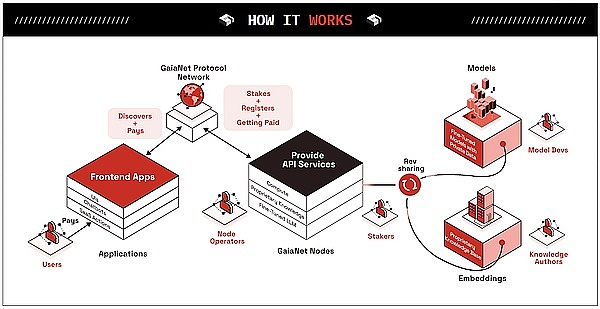
It is worth mentioning that there is also a role in the GaiaNet network, which is the component developer. By fine-tuning NFT-shaped models, knowledge bases, plug-ins and other components, they can obtain benefits from AI Agent developers with calling needs.
GaiaNet's core competitiveness in the Web3 + Agent track is reflected in:
GaiaNet is building a distributed edge computing node network controlled by individuals and enterprises to host fine-tuned AI models with proprietary domain knowledge and professional skills. This approach improves the diversity and professionalism of AI models.
GaiaNet's solution emphasizes protecting user privacy while providing AI capabilities. This is in line with Web3's emphasis on user data sovereignty.
GaiaNet allows individuals and enterprises to integrate their proprietary knowledge and skills into AI Agents. This decentralized sharing and application of knowledge is a manifestation of the spirit of Web3.
Opportunities and challenges: GaiaNet uses a node-based AI Agent creation and deployment environment to protect the intellectual property rights and data privacy of experts and users, and counters the centralized OpenAI GPT Store. GaiaNet has built a full set of decentralized AI reasoning usage scenarios, from front-end chatbot usage scenarios, node AI reasoning, fine-tuning model providers, knowledge base providers, to the bottom-level decentralized computing power supply. GaiaNet's challenge is how to fully productize the grand and complex roadmap, and how to open up to the composability of Web2 AI agents and other Web3 AI infrastructure.
IV. Conclusion
AI Agent not only represents a major leap in the field of AI, but is also an indispensable part of the Web3 ecosystem. Based on the collaboration of Multi-Agent, they will jointly create a more intelligent, efficient and decentralized world.
With the continuous emergence and development of top Web3 AI Agent projects such as HajimeAI and Spectral, we have witnessed the deep integration of AI Agent and blockchain technology, as well as their potential in promoting industry progress, optimizing user experience, lowering participation barriers and innovative applications. It not only provides developers and users with a wealth of choices, but also brings unprecedented vitality and possibilities to the entire Web3.
A DeFi Summer-style Web3 AI Summer is coming, and AI Agent has given it unlimited possibilities. Let us wait and see.
 JinseFinance
JinseFinance
















